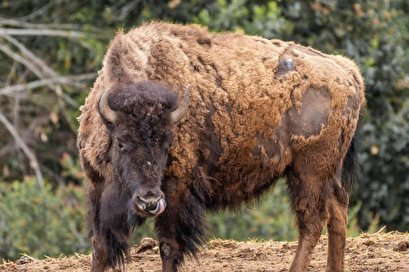TEHRAN, August 13 - Descendants of genetically pure Yellowstone National Park bison, part of a herd in northern Colorado, will make their way back to Montana tribal lands by way of the Oakland Zoo.
 TEHRAN, Young Journalists Club (YJC) -A small herd that started in 2015 with 10 cows at Colorado State University has grown to 77 animals.
TEHRAN, Young Journalists Club (YJC) -A small herd that started in 2015 with 10 cows at Colorado State University has grown to 77 animals.
In July, two Colorado-bred bulls were shipped to the zoo's new 13-acre bison habitat overlooking the ocean. Animal scientists hope the bulls will breed with cows from an 1800s herd from Elk Island National Park in Alberta, Canada, said Erin Dogan Harrison, the zoos's communications director.
The plan is part of a program to return heritage bison to tribal lands, specifically the Blackfeet Nation in northwest Montana.
The Blackfeet Nation's Iinnii Initiative brought a herd of 89 Elk Island Park bison back to tribal lands in 2018. Four Canadian and U.S. tribes comprising the Blackfeet Confederacy, the Siksika, the Kainai, the Piegan and Blackfeet, worked together to bring bison back to tribal property near Browning, Mont.
The herd is like a living inspiration for members of the Blackfeet Nation, said Teri Loring Dahle, who helped coordinate the project.
"Iinnii is a Blackfeet word that means 'taking hardships away.' When we see the buffalo, it means the Creator gave us everything we need in the form of this animal," she said.
"These animals are culturally and spiritually connected to our people, and I believe their homecoming will begin a healing of historical trauma to the Blackfeet people," Ervin Carlson, president of the Intertribal Buffalo Council, said in a press release.
"These buffalo will begin the longstanding efforts to restore buffalo to their historical mountain-front rangelands."
The Colorado buffalo are descendants of a wild herd that survived at Yellowstone in the early 1900s with help of conservationists and at the urging of President Theodore Roosevelt.
After being almost slaughtered to extinction in the late 1800s and early 1900s, about 500,000 bison now roam the United States. But most have been interbred with cattle and are being raised as livestock. The Yellowstone herd has no cattle DNA, scientists say.
The bison is North America's largest land mammal. Male bulls can reach weights of 2,000 pounds, and adult cows can weigh half that. They live in matriarchal societies and cows may give birth to a single calf every year.
Bison, who in 2016 were designated the national mammal of the United States, are considered a keystone species of the prairie because they grazed and fertilized the grasslands, helping to spread seeds of grasses and other prairie plants. Birds and other grassland animals co-evolved with the bison, scientists say.
The Oakland Zoo also received 20 pregnant females from the Elk Island herd. These bison are descended from animals captured on Blackfeet land in 1873, the zoo's Harrison said.
Breeding the Canadian bison with Yellowstone bison at the zoo will expand the genetic diversity of the tribal herds, she said.
Historically, Yellowstone Park bison were the only surviving U.S. buffalo that never were domesticated, and they have roamed free in the manner they did in prehistoric times.
But the Yellowstone herd has another problem -- up to half of the animals are infected with brucellosis, a livestock disease that causes cows to abort their calves. The disease can spread to cattle, as well as elk.
Ranchers who graze animals on public land nearby fear brucellosis will affect their herds.
Source: upi
 TEHRAN,
TEHRAN,